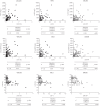Prognostic Value of MicroRNAs in Patients after Myocardial Infarction: A Substudy of PRAGUE-18
- PMID: 31781298
- PMCID: PMC6875251
- DOI: 10.1155/2019/2925019
Prognostic Value of MicroRNAs in Patients after Myocardial Infarction: A Substudy of PRAGUE-18
Abstract
Background: The evaluation of the long-term risk of major adverse cardiovascular events and cardiac death in patients after acute myocardial infarction (AMI) is an established clinical process. Laboratory markers may significantly help with the risk stratification of these patients. Our objective was to find the relation of selected microRNAs to the standard markers of AMI and determine if these microRNAs can be used to identify patients at increased risk.
Methods: Selected microRNAs (miR-1, miR-133a, and miR-499) were measured in a cohort of 122 patients from the PRAGUE-18 study (ticagrelor vs. prasugrel in AMI treated with primary percutaneous coronary intervention (pPCI)). The cohort was split into two subgroups: 116 patients who did not die (survivors) and 6 patients who died (nonsurvivors) during the 365-day period after AMI. Plasma levels of selected circulating miRNAs were then assessed in combination with high-sensitivity cardiac troponin T (hsTnT) and N-terminal probrain natriuretic peptide (NT-proBNP).
Results: miR-1, miR-133a, and miR-499 correlated positively with NT-proBNP and hsTnT 24 hours after admission and negatively with left ventricular ejection fraction (LVEF). Both miR-1 and miR-133a positively correlated with hsTnT at admission. Median relative levels of all selected miRNAs were higher in the subgroup of nonsurvivors (N = 6) in comparison with survivors (N = 116), but the difference did not reach statistical significance. All patients in the nonsurvivor subgroup had miR-499 and NT-proBNP levels above the cut-off values (891.5 ng/L for NT-proBNP and 0.088 for miR-499), whereas in the survivor subgroup, only 28.4% of patients were above the cut-off values (p = 0.001).
Conclusions: Statistically significant correlation was found between miR-1, miR-133a, and miR-499 and hsTnT, NT-proBNP, and LVEF. In addition, this analysis suggests that plasma levels of circulating miR-499 could contribute to the identification of patients at increased risk of death during the first year after AMI, especially when combined with NT-proBNP levels.
Copyright © 2019 M. Hromádka et al.
Conflict of interest statement
No potential conflict of interest was reported by the authors.
Figures


Similar articles
-
Evaluating Diagnostic and Prognostic Value of Plasma miRNA133a in Acute Chest Pain Patients Undergoing Coronary Angiography.Medicine (Baltimore). 2016 Apr;95(17):e3412. doi: 10.1097/MD.0000000000003412. Medicine (Baltimore). 2016. PMID: 27124025 Free PMC article.
-
Circulating microRNA-409-5p and USP7 are associated with left ventricular remodeling in patients with acute myocardial infarction.BMC Cardiovasc Disord. 2024 Nov 2;24(1):615. doi: 10.1186/s12872-024-04299-8. BMC Cardiovasc Disord. 2024. PMID: 39488705 Free PMC article.
-
High-sensitivity troponin T improves the prognostic value of N-terminal pro-B-type natriuretic peptide in patients with stable coronary artery disease: results from the LURIC Study.Clin Chem Lab Med. 2011 Jun;49(6):1053-8. doi: 10.1515/CCLM.2011.176. Epub 2011 May 17. Clin Chem Lab Med. 2011. PMID: 21574877
-
Association of N-terminal pro-brain natriuretic peptide level with adverse outcomes in patients with acute myocardial infarction: A meta-analysis.Heart Lung. 2021 Nov-Dec;50(6):863-869. doi: 10.1016/j.hrtlng.2021.07.007. Epub 2021 Jul 30. Heart Lung. 2021. PMID: 34340134 Review.
-
Usefullness of MicroRNAs in Predicting the Clinical Outcome of Patients with Acute Myocardial Infarction During Follow-Up: A Systematic Review.Genet Test Mol Biomarkers. 2022 May;26(5):277-289. doi: 10.1089/gtmb.2021.0283. Genet Test Mol Biomarkers. 2022. PMID: 35638909
Cited by
-
Peripheral Blood MicroRNAs as Potential Biomarkers of Myocardial Damage in Acute Viral Myocarditis.Genes (Basel). 2021 Mar 15;12(3):420. doi: 10.3390/genes12030420. Genes (Basel). 2021. PMID: 33804042 Free PMC article.
-
Anesthetics may modulate cancer surgical outcome: a possible role of miRNAs regulation.BMC Anesthesiol. 2021 Mar 9;21(1):71. doi: 10.1186/s12871-021-01294-w. BMC Anesthesiol. 2021. PMID: 33750303 Free PMC article. Review.
-
Serum microRNAs are key predictors of long-term heart failure and cardiovascular death after myocardial infarction.ESC Heart Fail. 2022 Oct;9(5):3367-3379. doi: 10.1002/ehf2.13919. Epub 2022 Jul 15. ESC Heart Fail. 2022. PMID: 35837763 Free PMC article.
-
Predictive value of miR-636 in patients with acute myocardial infarction undergoing percutaneous coronary intervention and its bioinformatics analysis.J Cardiothorac Surg. 2024 Oct 1;19(1):572. doi: 10.1186/s13019-024-03079-x. J Cardiothorac Surg. 2024. PMID: 39354590 Free PMC article.
-
Prioritization of microRNA biomarkers for a prospective evaluation in a cohort of myocardial infarction patients based on their mechanistic role using public datasets.Front Cardiovasc Med. 2022 Nov 3;9:981335. doi: 10.3389/fcvm.2022.981335. eCollection 2022. Front Cardiovasc Med. 2022. PMID: 36407428 Free PMC article.
References
-
- Tapanainen J. M., Lindgren K. S., Mäkikallio T. H., Vuolteenaho O., Leppäluoto J., Huikuri H. V. Natriuretic peptides as predictors of non-sudden and sudden cardiac death after acute myocardial infarction in the beta-blocking era. Journal of the American College of Cardiology. 2004;43(5):757–763. doi: 10.1016/j.jacc.2003.09.048. - DOI - PubMed
Publication types
MeSH terms
Substances
LinkOut - more resources
Full Text Sources
Medical
Research Materials
Miscellaneous

